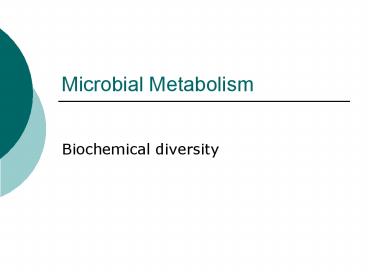Microbial Metabolism - PowerPoint PPT Presentation
1 / 60
Title:
Microbial Metabolism
Description:
Microbial Metabolism Biochemical diversity Metabolism Relationships Metabolism Pathways Metabolism Define Requirements Energy Enzymes Rate Limiting step Reaction time ... – PowerPoint PPT presentation
Number of Views:89
Avg rating:3.0/5.0
Title: Microbial Metabolism
1
Microbial Metabolism
- Biochemical diversity
2
Metabolism Relationships
3
Metabolism Pathways
4
Metabolism
- Define
- Requirements
- Energy
- Enzymes
- Rate
- Limiting step
- Reaction time
- Types
- Anabolic
- Endergonic
- Dehydration
- Biosynthetic
- Catabolic
- Exergonic
- Hydrolytic
- Degradative
- /- metabolites
5
Metabolic Diversity
- Energy generating metabolism
- Fermentation
- Alcohol
- Acid Formation
- Lactic Acid
- Mixed Acids
- Others
- Respiration
- Aerobic
- Anaerobic
- Biosynthesis of secondary metabolites
- Heterotrophic
- Autotrophic
6
Energy
- Forms
- Kinetic
- Potential
- Use
- Chemical
- Mechanical
- Electrical
- Radiation EM
- Chemical Types
- ATP
- UTP
- GTP
- Heat
- Byproduct
- 45
7
Various Types of Prokaryotic Energy Production
Processes
- Fermentation
- Anaerobic Respiration
- Aerobic Respiration
- Lithotrophy
- Photoheterotrophy
- Anoxygenic photosynthesis
- Methanogenesis
8
Enzymes
- Structure
- Protein
- Ribozyme ribosome
- Characteristic functions
- Active site
- Specific
- Modified Forms
- Inactive
- Active
- Coenzyme/Cofactor
- -ase
Polymerase
Others Lyases, Hydrolases, Isomerases,
Transferases
9
Enzyme Characteristics
10
Enzyme Structure
- Apoenzyme
- Protein
- Allosteric site
- Cofactor
- Metal ions
- Cu
- Zn
- Mg
- Fe
- Ca
- Co
- Mn
- Coenzyme
- Vitamins
- CoA
- NAD
- NADP
- FAD
?Allosteric site
11
Factors Affecting Enzymes
- Temperature
- pH
- Acids/Bases
- UV light
- Concentration of substrates (saturation)
- Inhibitors
12
Enzyme Inhibitors
- Classified
- Competitive
- _at_ active site
- Similar shape
- Binding
- Irreversible
- Reversible
- Noncompetitive
- _at_ allosteric site
- Change shape
- Binding
- Irreversible
- Reversible
13
Noncompetitive Enzyme Inhibition
14
Enzyme Inhibition Summary
Noncompetitive at Allosteric site
Competitive at active site
Excitatory Inhibitory
Reversible Irreversible
15
Glycolysis Embden-Meyerhoff
- Glycolytic
- Cytoplasm
- Anaerobic
- End products
- 2 Pyruvic acids
- 4-2 2 net ATP by substrate level
phosphorylation - 2 NADH
- 2 H20
16
Lactic Acid Formation
17
Glycolysis PPP
- Breakdown 5-6 C
- Cytoplasm
- Anaerobic
- End products
- 1 ATP
- 2 NADPH
- CO2
- 4,5,6,7 C
- AA
- Nucleotides
- Glycolytic pathways
- Photosynthesis
18
Glycolysis Entner-Duodoroff E-D
- Glycolytic
- Cytoplasm
- Anaerobic
- Different enzymes
- Pseudomonas
- Enterococcus
- End products
- 2-1 1 net ATP
- NADPH
- NADH
- 2 Pyruvic acids
- H20
NADP NADPH
19
Anaerobic Pathways Compared
20
Glycolytic Pathways used by various Bacteria
21
Anaerobic Processes
- Lactic Acid
- Lactobacillus
- Mixed Acid
- Enterobacteriaceae
- Butanediol
- Klebsiella
- Enterobacter
- Butyric Acid
- Clostridia
- Butanol-Acetone
- Clostridia
- Propionic Acid
- Corynebacteria
22
Fermentation
23
Fermentation Pathways
24
Fermentation Summary
- Anaerobic
- Cytoplasm
- Partial Oxidation
- Small amounts of ATP generated via substrate
level phosphorylation - Organic intermediaries as final electron
acceptors - End products
- Acid Lactic Acid, Acetic Acid, Butyric Acid,
Acetone - Alcohol Ethanol, Isopropyl
- Gas CO2, H2
- Contaminants
25
Summary
26
Carbohydrate Fermentation Tests
27
Phosphorylation
- Substrate Level
- Direct transfer of phosphate
- Glycolysis
- Oxidative Phosphorylation
- Electron transfer
- Chemiosmosis
- Photophosphorylation
- Light energy to chemical energy
28
Substrate Level Phosphorylation
29
Aerobic Respiration
30
Mitochondria of Eukaryotes
31
Plasma cell membrane
32
(No Transcript)
33
Acetyl CoA Formation
34
Acetyl CoA Final Structure
35
Krebs CycleTCA/Citric Acid
Eukaryotic Mitochondria Or Prokaryotic Cytoplasm
36
Oxidation in Krebs Cycle
37
Krebs Cycle Metabolites
- For every AcetylCoA
- 2 CO2
- 3 NADH
- 1 FADH2
- 1 ATP (substrate level phosphorylation from GTP)
- Regenerates
- CoA
- Oxaloacetic acid
38
Dehydrogenation
- Use of hydrogen in oxidative reactions
- Removal of electron from hydrogen
- Carried on vitamin B derivatives
- Energy released is trapped in chemical bonds
39
Redox Reactions
40
Oxidation
41
Reduction
42
Catabolism Anabolism
43
Eukaryotic ETC
44
Prokaryotic ETC
Vit B2 Riboflavin based Flavoproteins Metal
Proteins with ions (Fe, S, Cu) Iron based
Cytochromes (b,c1,c,a,a3) Ubiquiones based on Vit
K (CoEnzyme Q)
45
ETC Steps
- Electrons from NADH or FADH2 to flavoproteins
(FMN) - H pumped into periplasm
- Electrons transported
- To Iron-Sulfur proteins from NADH
- To CoQ from FADH2
- Cytochromes transfer electrons
- Final Electron Acceptor
- O2 if Aerobic
- Other inorganic molecule if Anaerobic
46
Proton Pump
47
ETC NAD ?NADH H
48
ETC Cytochromes
49
Cytochrome Oxidase (Cyt a Cyt a3)
50
Oxidase Test
Oxidase () Pseudomonas Oxidase (-) E.coli,
Proteus
51
ATP Synthetase
52
Anaerobic Respiration
- Use of another compound than O2 as final electron
acceptor in the ETC - Examples
- Nitrate ion NO3- Pseudomonas, E coli, Bacillus
- NO2-
- N2O
- N2
- Sulfate ion SO4 to H2S
- Methanogens
- Carbonate ion CO3 to CH4
- Methanogens
53
Nitrogen Reduction Test
Nitrate Reduction with Zinc
Nitrate Reduction Neg with zinc
Nitrate Reduction
54
Other Catabolic Processes
- Protein
- Deamination
- Decarboxylation
- Dehydrogenation
55
Other Catabolic Processes
- Lipid
- Glycerol
- FA
- Beta oxidation
- Acetyl CoA
56
Biosynthesis
- Polysaccharide
- Keto acids
- AA
- Glycerol from FA
- Lipid
- Glycerol FA
- AA
- Keto acids NH2
- Nucleotides
- Nitrogen bases from Keto acids NH2
- 5 C sugars from alternate CH20 Metabolism
57
Functions
- Polysaccharide
- Cell wall components
- LPS
- Lipid
- Cell wall
- Plasma membranes
- AA/Protein
- Cell wall / membrane components
- Enzymes
- Toxins
- Nucleotide
- DNA
- RNA
- ATP
- NAD
- NADP
58
Protein Synthesis and Enzyme Regulation
59
Metabolism Summary
60
Questions?































